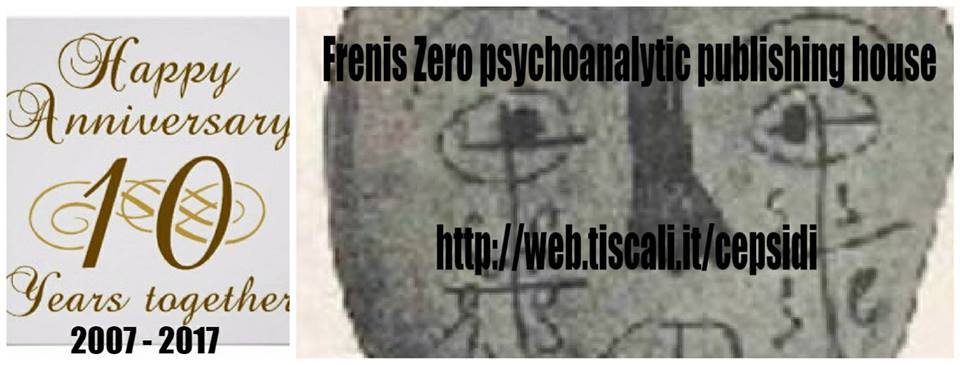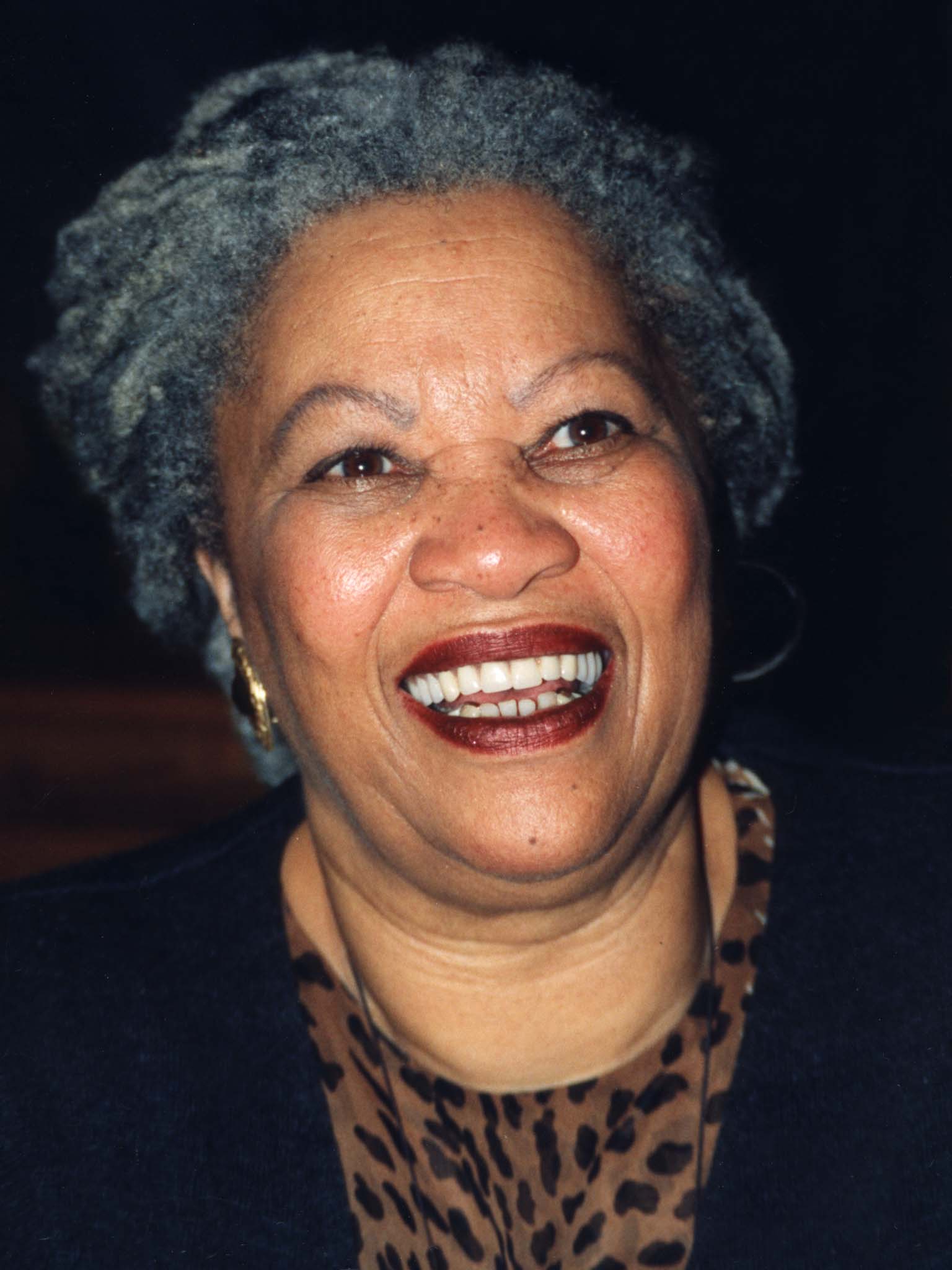|
A.S.S.E.Psi.
web site (History of Psychiatry and Psychoanalytic Psychotherapy
)
A.S.S.E.Psi.NEWS
(to subscribe our monthly newsletter)
Ce.Psi.Di. (Centro
di Psicoterapia Dinamica "Mauro Mancia")
Maitres
à dispenser (Our reviews about psychoanalytic congresses)
Biblio
Reviews (Recensioni)
Congressi
ECM (in italian)
Events
(our congresses)
Tatiana Rosenthal
and ... other 'psycho-suiciders'
Thalassa.
Portolano of Psychoanalysis
PsychoWitz - Psychoanalysis and Humor (...per ridere un po'!)
Giuseppe Leo's Art
Gallery
Spazio
Rosenthal (femininity and psychoanalysis)
Psicoanalisi
Europea Video
Channel
A.S.S.E.Psi. Video
Channel
Ultima uscita/New issue:
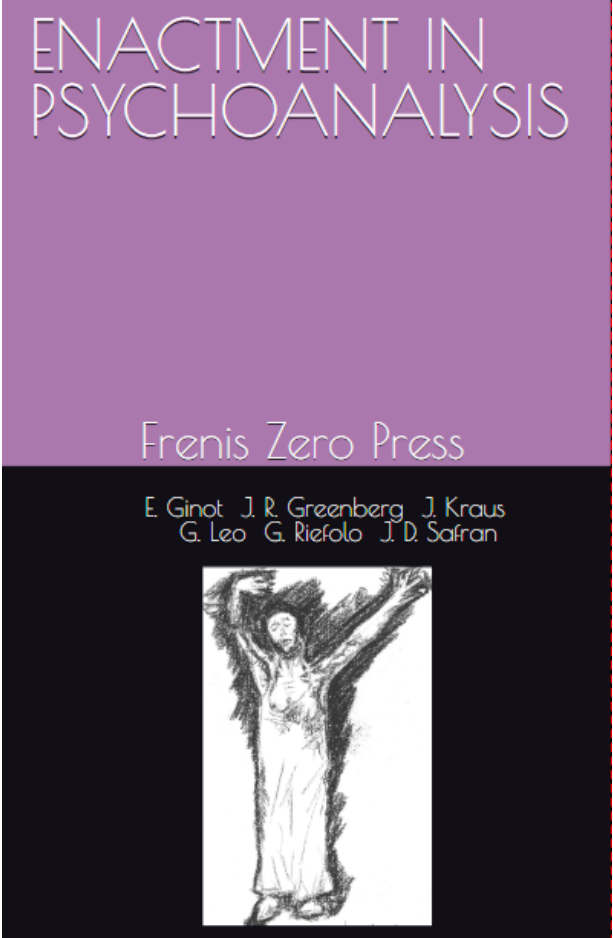
"Enactment
in Psychoanalysis"
Edited
by Giuseppe Leo & Giuseppe Riefolo
Writings
by: E. Ginot J.R.
Greenberg J. Kraus J.D. Safran
Publisher:
Frenis Zero
Collection:
Borders of Psychoanalysis
Year:
2019
Pages:
326
ISBN: 978-88-97479-15-4
Click
here to order the book
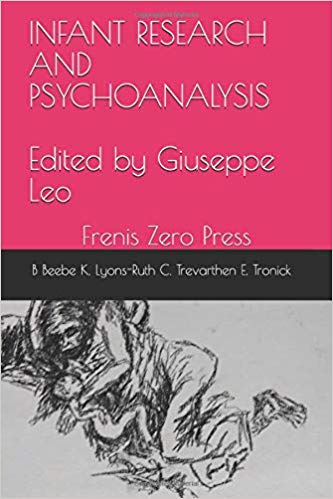
"Infant
Research and Psychoanalysis"
Edited
by Giuseppe Leo
Writings
by: B. Beebe K.
Lyons-Ruth J. P. Nahum E. Solheim C.
Trevarthen E. Z. Tronick L.
Vulliez-Coady
Publisher:
Frenis Zero
Collection:
Borders of Psychoanalysis
Year:
2018
Pages:
273
ISBN: 978-88-97479-14-7
Click
here to order the book
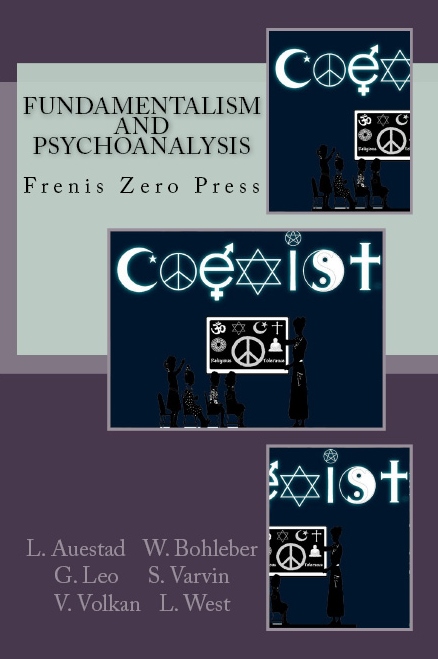
"Fundamentalism
and Psychoanalysis"
Edited
by Giuseppe Leo
Prefaced
by: Vamik D. Volkan
Writings
by: L. Auestad W.
Bohleber S. Varvin L. West
Publisher:
Frenis Zero
Collection:
Mediterranean Id-entities
Year:
2017
Pages:
214
ISBN: 978-88-97479-13-0
Click
here to order the book
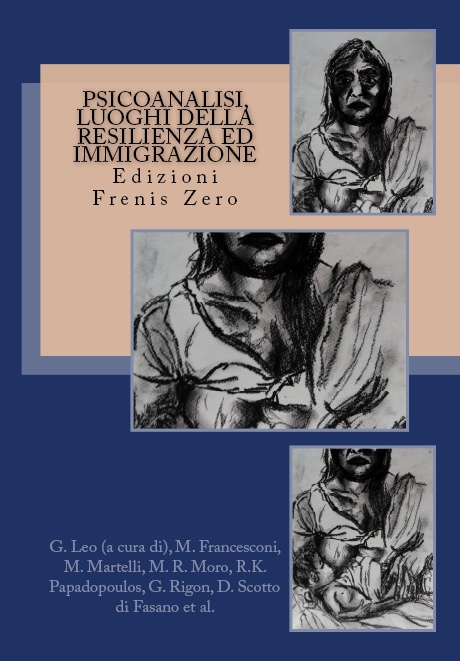
"Psicoanalisi, luoghi della resilienza
ed immigrazione"
Edited
by/a cura di:
Giuseppe Leo
Writings by/scritti di:
S.
Araùjo Cabral, L.
Curone,
M. Francesconi,
L.
Frattini,
S.
Impagliazzo,
D. Centenaro Levandowski, G. Magnani, M. Manetti, C. Marangio,
G. A. Marra e Rosa, M. Martelli, M. R. Moro,
R. K. Papadopoulos, A. Pellicciari,
G. Rigon,
D.
Scotto di Fasano,
E. Zini, A. Zunino
Editore/Publisher: Edizioni Frenis Zero
Collection/Collana: Mediterranean
Id-entities
Anno/Year:
2017
Pagine/Pages:
372
ISBN:978-88-97479-11-6

"Psicoanalisi in Terra Santa"
Edited
by/a cura di: Ambra Cusin & Giuseppe Leo
Prefaced by/prefazione
di:
Anna Sabatini Scalmati
Writings by/scritti di:
H. Abramovitch A. Cusin M. Dwairy A. Lotem M.
Mansur M. P. Salatiello Afterword
by/ Postfazione
di:
Ch. U. Schminck-Gustavus
Notes by/ Note di: Nader Akkad
Editore/Publisher: Edizioni Frenis Zero
Collection/Collana: Mediterranean
Id-entities
Anno/Year:
2017
Pagine/Pages:
170
ISBN:978-88-97479-12-3
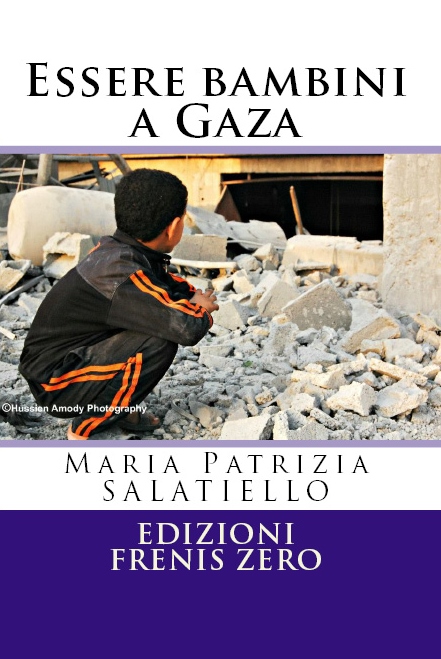
"Essere bambini a Gaza. Il trauma
infinito"
Authored
by/autore: Maria Patrizia Salatiello
Editore/Publisher: Edizioni Frenis Zero
Collection/Collana: Mediterranean
Id-entities
Anno/Year:
2016
Pagine/Pages:
242
ISBN:978-88-97479-08-6

Psychoanalysis,
Collective Traumas and Memory Places (English Edition)
Edited
by/a cura di: Giuseppe Leo Prefaced by/prefazione
di:
R.D.Hinshelwood
Writings by/scritti di: J. Altounian
W. Bohleber J. Deutsch
H. Halberstadt-Freud Y. Gampel
N. Janigro R.K. Papadopoulos
M. Ritter S. Varvin H.-J. Wirth
Editore/Publisher: Edizioni Frenis Zero
Collection/Collana: Mediterranean
Id-entities
Anno/Year:
2015
Pagine/Pages:
330
ISBN:978-88-97479-09-3
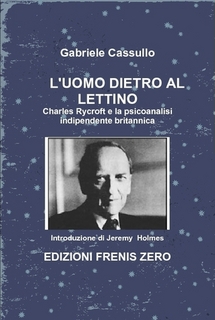
"L'uomo
dietro al lettino" di
Gabriele Cassullo
Prefaced
by/prefazione di: Jeremy
Holmes
Editore/Publisher: Edizioni Frenis Zero
Collection/Collana: Biografie
dell'Inconscio
Anno/Year:
2015
Pagine/Pages:
350
ISBN:978-88-97479-07-9
Prezzo/Price:
€ 29,00
Click
here to order the book
(per Edizione
rilegata- Hardcover clicca qui)
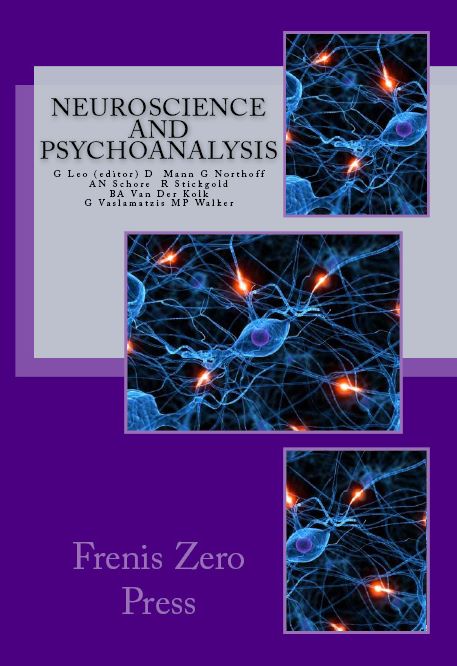
"Neuroscience
and Psychoanalysis" (English Edition)
Edited by/a cura di: Giuseppe Leo Prefaced by/prefazione
di: Georg Northoff
Writings by/scritti di: D. Mann
A. N. Schore R. Stickgold
B.A. Van Der Kolk G. Vaslamatzis M.P. Walker
Editore/Publisher: Edizioni Frenis Zero
Collection/Collana: Psicoanalisi e neuroscienze
Anno/Year: 2014
Pagine/Pages: 300
ISBN:978-88-97479-06-2
Prezzo/Price: € 49,00
Click
here to order the book
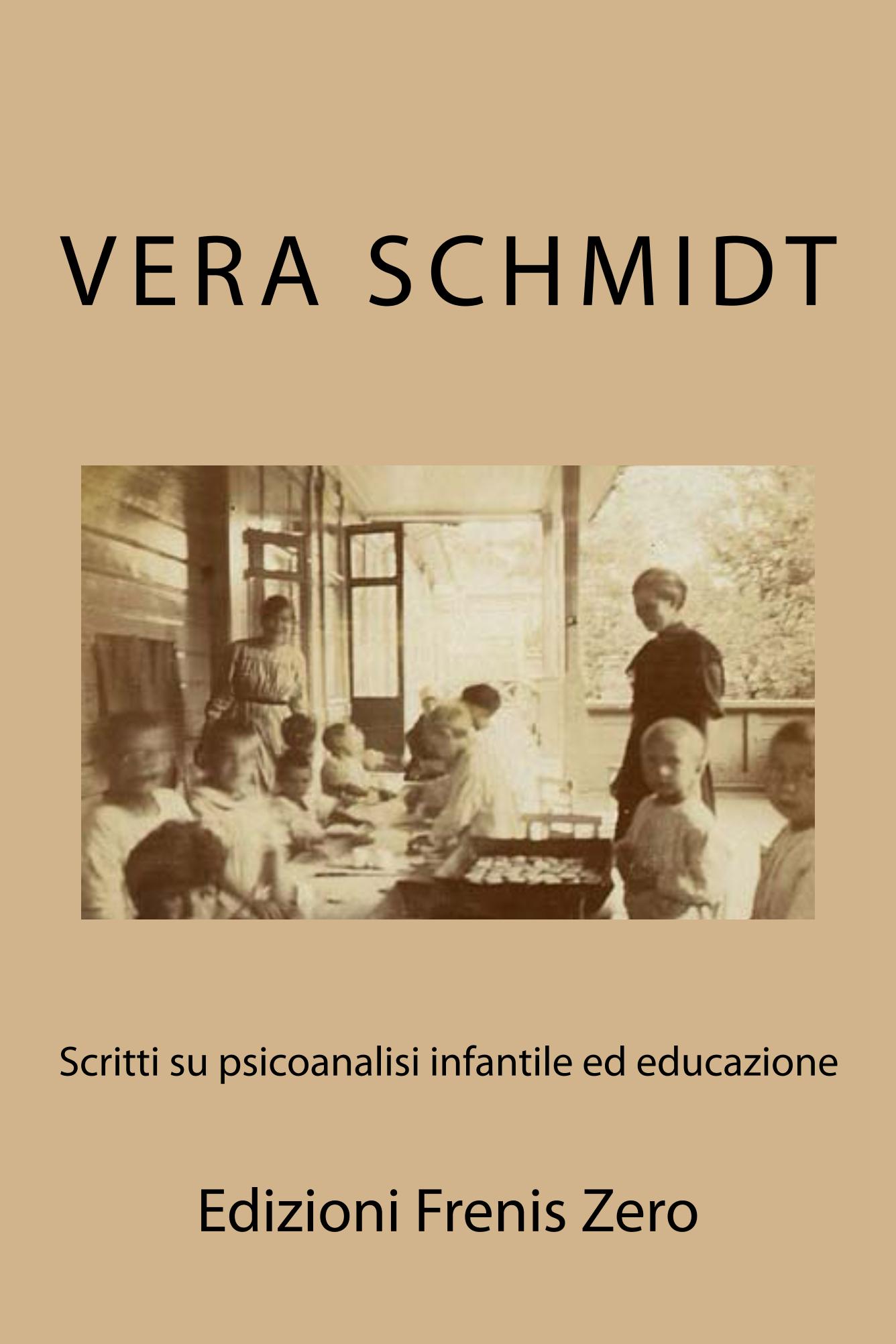
Vera
Schmidt, "Scritti su psicoanalisi infantile ed
educazione"
Edited by/a cura di: Giuseppe Leo Prefaced by/prefazione
di: Alberto Angelini
Introduced by/introduzione di: Vlasta Polojaz
Afterword by/post-fazione di: Rita Corsa
Editore/Publisher: Edizioni Frenis Zero
Collana: Biografie dell'Inconscio
Anno/Year: 2014
Pagine/Pages: 248
ISBN:978-88-97479-05-5
Prezzo/Price: € 29,00
Click
here to order the book
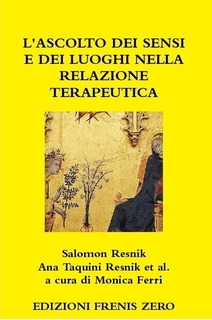
Resnik,
S. et al. (a cura di Monica Ferri), "L'ascolto dei
sensi e dei luoghi nella relazione terapeutica"
Writings by:A.
Ambrosini, A. Bimbi, M. Ferri, G.
Gabbriellini, A. Luperini, S. Resnik,
S. Rodighiero, R. Tancredi, A. Taquini Resnik,
G. Trippi
Editore/Publisher: Edizioni Frenis Zero
Collana: Confini della Psicoanalisi
Anno/Year: 2013
Pagine/Pages: 156
ISBN:978-88-97479-04-8
Prezzo/Price: € 37,00
Click
here to order the book
Silvio
G. Cusin, "Sessualità e conoscenza"
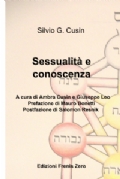
A cura di/Edited by: A. Cusin & G. Leo
Editore/Publisher: Edizioni Frenis Zero
Collana/Collection: Biografie dell'Inconscio
Anno/Year: 2013
Pagine/Pages: 476
ISBN: 978-88-97479-03-1
Prezzo/Price:
€ 39,00
Click
here to order the book
AA.VV.,
"Psicoanalisi e luoghi della riabilitazione", a cura
di G. Leo e G. Riefolo (Editors)
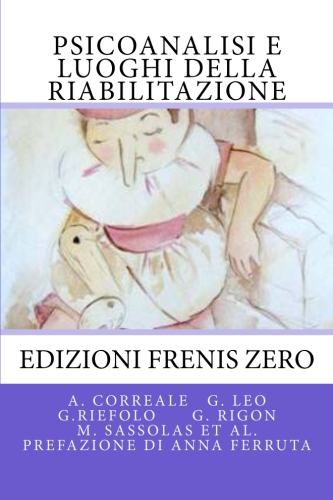
A cura di/Edited by: G. Leo & G. Riefolo
Editore/Publisher: Edizioni Frenis Zero
Collana/Collection: Id-entità mediterranee
Anno/Year: 2013
Pagine/Pages: 426
ISBN: 978-88-903710-9-7
Prezzo/Price:
€ 39,00
Click
here to order the book
AA.VV.,
"Scrittura e memoria", a cura di R. Bolletti (Editor)

Writings by: J.
Altounian, S. Amati Sas, A. Arslan, R. Bolletti, P. De
Silvestris, M. Morello, A. Sabatini Scalmati.
Editore/Publisher: Edizioni Frenis Zero
Collana: Cordoglio e pregiudizio
Anno/Year: 2012
Pagine/Pages: 136
ISBN: 978-88-903710-7-3
Prezzo/Price: € 23,00
Click
here to order the book
AA.VV., "Lo
spazio velato. Femminile e discorso
psicoanalitico"
a cura di G. Leo e L. Montani (Editors)
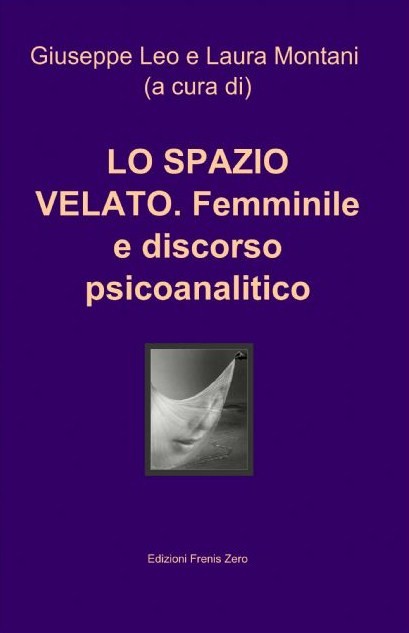
Writings by: A.
Cusin, J. Kristeva, A. Loncan, S. Marino, B.
Massimilla, L. Montani, A. Nunziante Cesaro, S.
Parrello, M. Sommantico, G. Stanziano, L.
Tarantini, A. Zurolo.
Editore/Publisher: Edizioni Frenis Zero
Collana: Confini della psicoanalisi
Anno/Year: 2012
Pagine/Pages: 382
ISBN: 978-88-903710-6-6
Prezzo/Price: € 39,00
Click
here to order the book
AA.VV., Psychoanalysis
and its Borders, a cura di
G. Leo (Editor)

Writings by: J. Altounian, P.
Fonagy, G.O. Gabbard, J.S. Grotstein, R.D. Hinshelwood, J.P.
Jimenez, O.F. Kernberg, S. Resnik.
Editore/Publisher: Edizioni Frenis Zero
Collana/Collection: Borders of Psychoanalysis
Anno/Year: 2012
Pagine/Pages: 348
ISBN: 978-88-974790-2-4
Prezzo/Price: € 19,00
Click
here to order the book
AA.VV.,
"Psicoanalisi e luoghi della negazione", a cura di A.
Cusin e G. Leo

Writings by:J.
Altounian, S. Amati Sas, M. e M. Avakian, W. A.
Cusin, N. Janigro, G. Leo, B. E. Litowitz, S. Resnik, A.
Sabatini Scalmati, G. Schneider, M. Šebek,
F. Sironi, L. Tarantini.
Editore/Publisher: Edizioni Frenis Zero
Collana/Collection: Id-entità mediterranee
Anno/Year: 2011
Pagine/Pages: 400
ISBN: 978-88-903710-4-2
Prezzo/Price: € 38,00
Click
here to order the book
"The Voyage Out" by Virginia
Woolf

Editore/Publisher: Edizioni Frenis Zero
ISBN: 978-88-97479-01-7
Anno/Year: 2011
Pages: 672
Prezzo/Price: € 25,00
Click
here to order the book
"Psicologia
dell'antisemitismo" di Imre Hermann
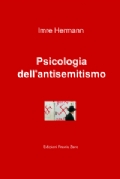
Author:Imre Hermann
Editore/Publisher: Edizioni Frenis Zero
ISBN: 978-88-903710-3-5
Anno/Year: 2011
Pages: 158
Prezzo/Price: € 18,00
Click
here to order the book
"Id-entità mediterranee.
Psicoanalisi e luoghi della memoria" a cura di Giuseppe Leo
(editor)
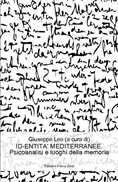
Writings by: J.
Altounian, S. Amati Sas, M. Avakian, W. Bohleber, M. Breccia, A.
Coen, A. Cusin, G. Dana, J. Deutsch, S. Fizzarotti Selvaggi, Y.
Gampel, H. Halberstadt-Freud, N. Janigro, R. Kaës, G. Leo, M.
Maisetti, F. Mazzei, M. Ritter, C. Trono, S. Varvin e H.-J. Wirth
Editore/Publisher: Edizioni Frenis Zero
ISBN: 978-88-903710-2-8
Anno/Year: 2010
Pages: 520
Prezzo/Price: € 41,00
Click
here to have a preview
Click
here to order the book
"Vite soffiate. I vinti della
psicoanalisi" di Giuseppe Leo
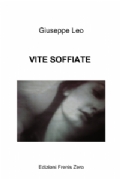
Editore/Publisher: Edizioni Frenis Zero
Edizione: 2a
ISBN: 978-88-903710-5-9
Anno/Year: 2011
Prezzo/Price: € 34,00
Click
here to order the book
"La Psicoanalisi e i suoi
confini" edited by Giuseppe Leo
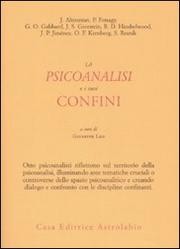
Writings by: J.
Altounian, P. Fonagy, G.O. Gabbard, J.S. Grotstein, R.D.
Hinshelwood, J.P. Jiménez, O.F. Kernberg, S. Resnik
Editore/Publisher: Astrolabio Ubaldini
ISBN: 978-88-340155-7-5
Anno/Year: 2009
Pages: 224
Prezzo/Price: € 20,00
"La Psicoanalisi. Intrecci Paesaggi
Confini"
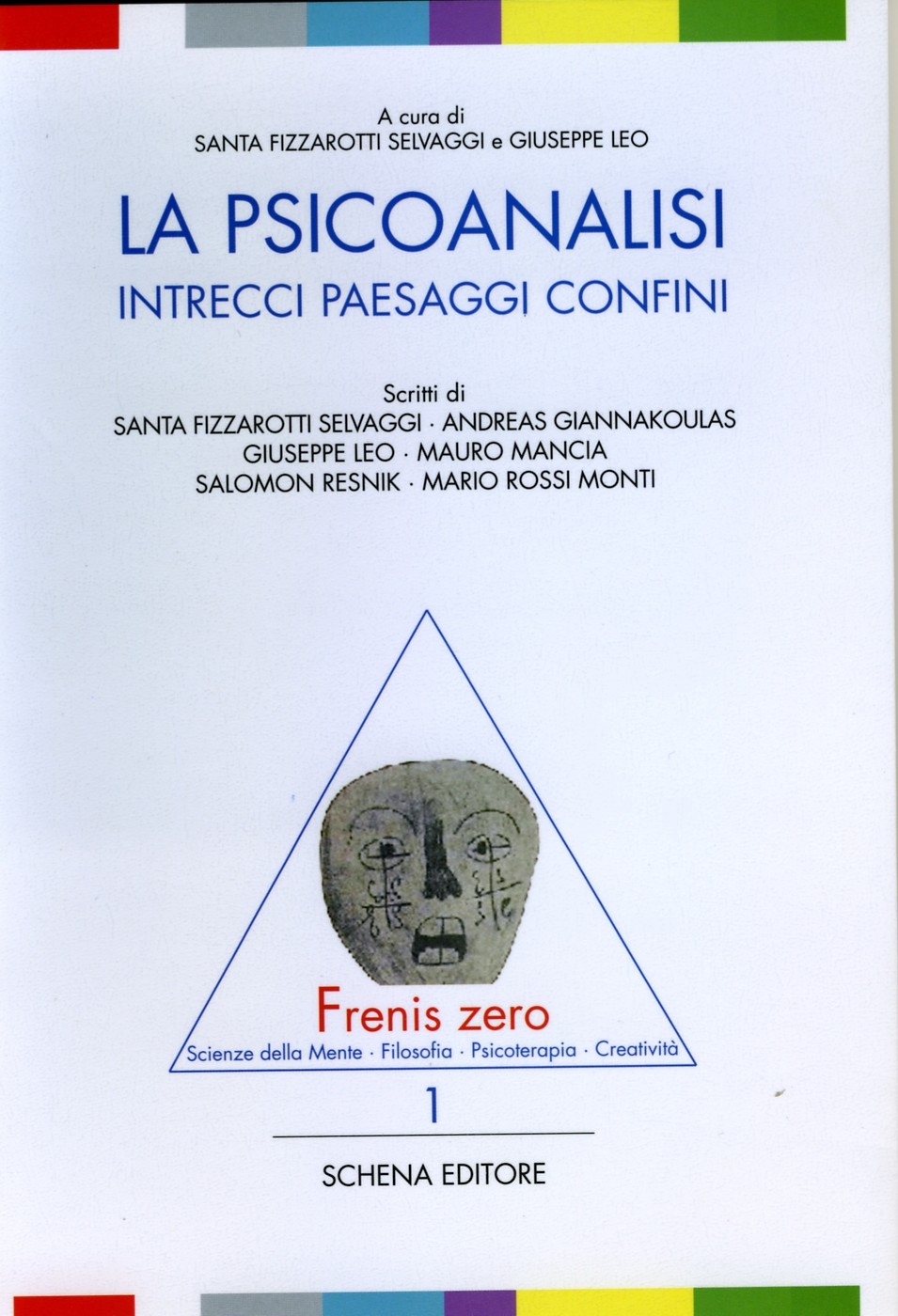
Edited by S. Fizzarotti Selvaggi, G.Leo.
Writings by: Salomon Resnik, Mauro Mancia, Andreas Giannakoulas,
Mario Rossi Monti, Santa Fizzarotti Selvaggi, Giuseppe Leo.
Publisher: Schena Editore
ISBN 88-8229-567-2
Price: € 15,00
Click here to order the
book |
|
1.
Introduction
The
opening of The Bluest Eye (1970) in autumn with a monologue by
Claudia, who narrates the story both from her childhood point of view
and from her adult perspective in the late 1960s, makes it clear that
the loss of innocence, of marigolds, and of Pecola’s baby does not
call for why these things happened: "But since why is difficult
to handle, one must take refuge in how" (p. 4). Evinced from a
little girl’s perspective, this apparent convenience of "how"
over "why" features an indulgent self-containing psychic
schemata of the black communities in Morrison’s The Bluest Eye and
Sula that divests them of a disposition to subvert their constricted
view on life and that is tantamount to their nihilistic suspension of
hope to eliminate degenerative traits in what West (1994) terms as
"self-destructive inhumane actions" (p. 30). It seems that
the characters (except Sula) in both the novels are preoccupied with
events per se as a process determined and manipulated by a force
beyond their comprehensibility and/or authority; that they are more
prone to events than they can exercise their libertarian free will in
their most convenient moments; and that under circumstances they are
not given alternatives for asserting their normalcy (of which they
hardly have a clear-headed notion, for, to most of them, degeneracy
has become a kind of normalcy).
The
key motivation of this research springs from the need to understand
Morrison’s politics of representation of black degeneracy—a
politics which she claims to have developed out of her disappointment
at the absence of "some intimacy, some direction, some
voice" in the works of black authors like Ralph Ellison and
Richard Wright, whose books "were saying something about it or us
that revealed something about us to you, to others, to white people,
to men" (Italic, orig. Interview by Ruas, 1981, p. 96). With a
grit to delve deeper into the black reality, she approaches it like an
explorer:
There
is a mask that sometimes exists when black people talk to white
people. Somehow it seems to me that it spilled over into the fiction.
I never thought that when I was reading black poetry, but when I began
to write…When the locality is clear, fully realized, then it becomes
universal. I knew there was something I wanted to clear away in
writing, so I used the geography of my childhood, the imagined
characters based on bits and pieces of people. (Interview by Ruas,
1981, p. 96)
Morrison’s
fictional representation of black characters in The Bluest Eye and
Sula, besides making her exceptional among Black American writers,
poses two questions: Is degeneracy an essential attribute of black
characters or Is it superimposed on them by their perceptions? With
regard to the binary integration of Nel-Sula characters, Morrison
views evil on the relativity ground:
I
started by thinking that one can never really define good and evil.
Sometimes good looks like evil; sometimes evil looks like good—you
never really know what it is. It depends on what uses you put it to.
Evil is as useful as good is, although good is generally more
interesting; it’s more complicated. I mean, living a good life is
more complicated than living an evil life. (Morrison, qtd. interviewed
by Stepto, 1994, p. 13-14)
Morrison’s
view is intriguing and does not clearly vouch for black degeneracy in
the two novels. The inviolable cycle of black life entrapped in
decadence, which both makes the characters morally inferior and
presents them as a victimized class in the broader white-dominated
socio-political suppressive reality of America, should be studied from
a phenomenological perspective.
In
the first novel, the identical behavioural pattern of black characters
is suggested by individual deviations: Pecola’s impossible wish for
a pair of blue eyes as the only way for her presumptuous escape from
the curse of ugliness culminates in her being raped by her father who
perpetrates this event in a blurred consciousness as if it were not an
act of free will or there was not an alternative to express his blend
of hatred and tenderness towards his daughter; Claudia’s jealous
abhorrence towards white hegemony proves futile when her deduction
grasps the ubiquity or rootedness of white admiration in the community’s
psyche; Mr. Henry’s affection for Claudia and Frieda turns lusty as
he touches Frieda—an act which Claudia conceives of making one
"[f]eel good" (BE, p. 77); Pauline and Cholly’s
love-marriage comes to a mutually inflicting phenomenon leading to a
disintegrated relationship with their children; and the misanthropic
revulsion of the mixed-descent Elihue Micah Whitcomb who publicly
renames himself Soaphead Church for his deceptive impersonation of a
true Spiritualist and Psychic Reader in Lorain turns him into a
speculative villain. Focusing on the female characters’ plight in
The Bluest Eye, Kuenz (1993) makes a broad observation which implies
Morrison’s motive behind the representation of black characters in a
degenerative form:
With
these characters, Morrison literalizes the novel's overall conflation
of black female bodies as the sites of fascist invasions of one kind
or another, as the terrain on which is mapped the encroachment and
colonization of African-American experiences, particularly those of
its women, by a seemingly hegemonic white culture. The Bluest Eye as a
whole documents this invasion—and its concomitant erasure of
specific local bodies, histories, and cultural productions—in terms
of sexuality as it intersects with commodity culture. Furthermore,
this mass culture and, more generally, the commodity capitalism that
gave rise to it, is in large part responsible—through its capacity
to efface history-for the "disinterestedness" that Morrison
condemns throughout the novel. Beyond exemplifying this, Morrison's
project is to rewrite the specific bodies and histories of the black
Americans whose positive images and stories have been eradicated by
commodity culture. She does this formally by shifting the novel's
perspective and point of view, a narrative tactic that enables her, in
the process, to represent black female subjectivity as a layered,
shifting, and complex reality. (421)
Morrison
brings out what tends to be veiled by the dominant culture of denying
the obvious. In Sula, black life is equally manipulated by evil:
Shadrack’s morbid custom of celebrating National Suicide Day
developed as a means of coping with his own fear of death as a victim
of World War I shell shock is effected through the deaths of the
marchers, men and women in the tunnel; Rochelle’s living a Creole
whore’s life makes her stoically apathetic towards her mother and
daughter; Eva Peace’s abandonment by BoyBoy in a dire challenge
forcing her to amputate her leg for an insurance and her burning of
war-traumatized Ralph to death consolidates the anti-humane part of
Sula’s character; Hannah’s addiction to male company flares up
Sula’s primordial craving; and above all, Sula’s capricious
killing of Chicken little and her exploitation of womanhood through
unfettered experimentation of sensuality with men.
If
the characters in both the novels share a proclivity towards the
immoral, doesn’t it follow that their ethnicity needs to be
exorcised from evil? To approach this question, this research
initially maintain that the black characters in both the novels
inhabit a world which is dictated much less by a religious belief
system than by a collective, convoluted notion of existence germinated
by some external stimuli, e.g. trauma. Alexander asserts:
In
Morrison’s fictional world, God’s characteristics are not limited
to those represented by the traditional Western notion of the Trinity:
Father, Son, and Holy Ghost. Instead, God possesses a fourth face, one
that is an explanation for all those things – the existence of evil,
the suffering of the innocent and just – that seem so inexplicable
in the face of a religious tradition that preaches the omnipotence of
a benevolent God. (293)
The
"fourth face" can be interpreted as the process of
dehumanization that characters like Cholly go through from the very
first moment of life in God’s world which also accounts for the
perpetuation of the unacceptable. Apparently, the individual cases of
evil imply a kind of commonness which can be interpreted by Jung’s
unconscious. Jung found that the personal unconscious "rests upon
a deeper layer, which does not derive from personal experience and is
not a personal acquisition but is inborn" (Jung, 1959, 1968, p.
3). This "deeper layer" is Jung’s collective unconscious.
Jung explains:
I
have chosen term "collective" because this part of the
unconscious is not individual but universal; in contrast to the
personal psyche, it has contents and modes of behaviour that are more
or less everywhere and in all individuals. It is, in other words,
identical in all men and thus constitutes a common psychic substance
of a suprapersonal nature which is present in every one of us. (pp.
3-4)
However,
the "common psychic substance of a suprapersonal nature" of
Jung’s "unconscious" defines the commonness of the black
characters within the texts so intrinsically that it does not
incriminate the conscious subjugation and relegation of the black
communities in the socio-economic meta-system to "the inferior
other" that affects how an individual or community responds to
the vicariously acquired self as well as to the condescending reality.
Hence, while probing into the genesis of the commonness and
singularity of degenerative behaviours of the black characters, we
cannot rule out the perceptional impact on their social knowledge of
identity and behaviour.
This
paper investigates whether the root of black degeneracy lies in the
collective unconscious of the black communities living respectively in
Lorain and in the Bottom or is generated by their individual and
collective perceptions as vulnerable entities in Morrison’s first
two novels The Bluest Eye and Sula. Using Jung’s theory of the
unconscious, it firstly probes into the black psyche for understanding
the proclivity towards evil. Then it aims to undermine the common
approaches to black life, e.g., feminism, psychoanalysis, archetypal
criticism, in Morrison’s novels in favour of a more phenomenological
analysis of the black characters as Morrison actually created them in
the light of her experience in America. The findings of this paper
reach a conclusion that it is perceptions of the reality that account
for the prevalence of degenerate behaviours in the two novels. In the
second section, the paper shows the black community’s view on evil
and its repercussions that makes up the apparent collectivity of
living. The findings of this paper will contribute to understanding
the world of Morrison’s black
characters in terms of socio-political implications, not ignoring the
fact that perception precedes the unconscious.
2.
How the collective unconscious interprets black characters’ psyche
In
their remarks on the rape and men’s victimization of women in The
Bluest Eye, feminist critics often interpret such human misdeeds in
terms of archetypes; vices like Pecola’s rape are aligned with the
myth of Philomela’s brutal rape by her sister’s husband, Tereus (Surányi
2007; Miner, 2005; O’Reilly, 2004; & Pozorski, 2003). However,
mythologizing evil reverts to the process dismissing the understanding
of its precedents in reality, as Claudia the narrator’s preference
implies.
The
commonness of behaviours may be accounted for the deep-rooted notion
of fate. In Part Two of Sula that opens in 1937, the black community’s
eccentric definition of anomalies is outlined analogically in
connection with incongruous phenomena—a definition which also
explains their belief system:
What
was taken by outsiders to be slackness, slovenliness or even
generosity was in fact a full recognition of the legitimacy of forces
other than good ones. They did not believe doctors could heal—for
them, none ever had done so. They did not believe death was accidental—life
might be, but death was deliberate. They did not believe Nature was
ever askew—only inconvenient. Plague and drought were as "natural"
as springtime. If milk could curdle, God knows robins could fall. The
purpose of evil was to survive it and they determined (without ever
knowing they had made up their minds to do it) to survive floods,
white people, tuberculosis, famine and ignorance. They knew anger well
but not despair, and they didn’t stone sinners for the same reason
they didn’t commit suicide—it was beneath them. (S, p. 90)
Considered
logically, the way the black people synchronize unconnected events
(e.g. plague and drought are comparable to springtime; milk curdling
is like robins falling) suggests their insensibility to rational
phenomenal processes and their fallibility of thought. Moreover, the
self-justified credo of the dwellers of the Bottom regarding fate and
evil, which Christian (1999) terms a "specific belief
system" (p. 28), implies their collective unconscious, their
repose to the inevitable and their susceptibility to the external
world—not less to themselves—which is dominated by the white
community. If beliefs are taken "as cognitions that structure
outcome expectancies for actions by the actor (Bond, 2005, p.
43)," then the black characters, particularly Cholly Breedlove,
lack awareness of the direct consequences of their actions only
because of their incongruous connection of ideas in their belief
system. Sometimes the survival-first concern overweighs the sense of
guilt, an instance of which is found in Sula and Nel’s tension after
they unintentionally kill Chicken Little and only apprehend witness by
Shadrack from the other side of the river. This concern manifests a
tendency to feign passivity when evil materializes in action—be the
evil related or unrelated to the characters. In The Bluest Eye the
black community pretends to have no part in the evil of Cholly’s
incest with their self-defensive treatment of it through mere remarks
which Claudia discovers:
And
I believe our sorrow was the more intense because nobody else seemed
to share it. They were disgusted, amused, shocked, outraged, or even
excited by the story. But we listened for the one who would say,
"Poor little girl," or "Poor baby," but there was
only head-wagging where those words should have been. We looked for
eyes creased with concern, but saw only veils. (BE, p. 149)
To
suppress due reactions is to normalize evil. Restricting their
response to evil merely to verbal expressions, they let "run its
course, fulfill itself, and never invented ways either to alter it, to
annihilate it or to prevent its happening again" (Sula, pp.
89-90). What remains for the weak is to survive evil in the most
expedient way. Claudia considers this communal mechanism of surviving
an evil as a kind of finding a scapegoat for their collective flaws,
their human weaknesses, of finding a diametric other among themselves
against which they can deem themselves to be free of evil:
All
of our waste which we dumped on her and which she absorbed. And all of
our beauty, which was hers and which she gave to us. All of us—all
who knew her—felt so wholesome after we cleaned ourselves on her. We
were so beautiful when we stood astride her ugliness. Her simplicity
decorated us, her guilt sanctified us, her pain made us glow with
health, her awkwardness made us think we had a sense of humor. Her
inarticulateness made us believe we were eloquent. Her poverty kept us
generous. Even her waking dreams we used – to silence our own
nightmares. And she let us, and thereby deserved
our contempt. We honed our egos on her, padded our characters with her
frailty, and yawned in the fantasy of our strength. (BE, p. 162-3)
The
collective feeling of contempt towards evil is actually the reflection
of their self-loathing which is connected to their inferiority complex.
Smith (2012) opines that "the roots of their self-disgust lie so
deep, that they do not recognize them for what they are ... they
project those feelings upon the most vulnerable members of their
community, in this case the young Pecola [...] has been destroyed not
only by her rape at the hands of her father, but by the abuse that
members of her community heap upon her" (p. 20). The blacks of
the Bottom in Sula exhibit a similar disposition in their collective
hatred for Sula’s cruelty with Eva Peace, and her indiscriminate sex
adventures with married men as well as white men. In a way, Sula
becomes a social scapegoat like Pecola; in Nigro’s (1999) words:
"After the death of Sula—the pariah, the devil, the outcast—the
community’s role of defining itself through acceptance and
disapproval of one of its members shifts" (Marie Nigro, in Bloom’s
Sula p. 23).
In
The Bluest Eye, Soaphead Church interprets evil in an exceptional
fashion which manifests his convoluted thought of using the concept of
evil to his advantage; he boastfully considers human evil as a God’s
flaw and hence an essential part of humanity: "Evil existed
because God had created it" (BE, p. 137). Later shaken by the
frailty of his pretension, he describes, in his letter to God, the
tradition of degeneracy based on their sense of superiority over
blacks for a white ancestor’s bloodline – the collective
superciliousness:
In
retaining the identity of our race, we held fast to those
characteristics most gratifying to sustain and least troublesome to
maintain. Consequently we were not royal but snobbish, not
aristocratic but class-conscious; we believed authority was cruelty to
our inferiors, and education was being at school. We mistook violence
for passion, indolence for leisure, and thought recklessness was
freedom…Our manhood was defined by acquisitions. Our womanhood by
acquiescence. And the smell of your fruit and the labor of your days
we abhorred (BE, p. 140-1).
In
Soaphead’s mixed-blood community, degeneracy has a distinct
dimension and mainly spawns from his early exposure to superficial
egoism and its contrariness complacently endured under his father’s
"controlled violence" that generated in him "hard
habits and a soft imagination" (BE, p. 134). His admittance
destabilizes the ground of the unconscious to the extent that being
liability to evil become cross-ethnic.
3.
Why the collective unconscious is not the primary cause
In
her conversation with Black Creation Annual about the thematic trends
in the writing of the 1970s, Morrison (1974) clarifies on the Black
people’s perception of evil "as a fourth dimension in their
lives" and their mechanism "to protect themselves from evil"
unlike "that puritannical thing which says if you see a witch,
then burn it, or if you see something, then kill it." (p. 8)
Morrison continues:
I’m
not saying that Black people don’t kill each other. I’m talking
about the way they perceive evil and how they act upon that perception.
They don’t destroy evil. It’s as though God has four faces for
them – not just the Trinity, but four. I know instinctly that we do
not regard evil the same way as white people do. We have never done
that. White people’s reaction to something that is alien to them is
to destroy it. That’s why they have to say Black people are
worthless and ugly. They need all the psychological "do" in
order to do something simple like ripping some people off. That’s
why they behave the way they do. (Morrison, qtd. in Taylor-Gurthrie,
1994, p. 8)
The
social imagination of the black individual as lacking violence against
evil epitomizing ugliness proves caustic to the black self. It caters
to the black characters’ inability to resist the imposition of
inferior racial identity and hereditary inferiority complex in times
of America’s white supremacy. Almost all the characters foster an
inextricable blackness-ugliness analogy generated by the dominant
white aesthetics. The Breedloves in The Bluest Eye believe that "they
were ugly" (p. 28) enough to be considered inferior, and are
destined to be so in thoughts and behavior. This belief is so
deep-rooted that no one within and outside the community "could
convince them that they were not relentlessly and aggressively ugly"
(p. 28), and defines them or they define themselves with this ugliness
that springs from their conviction:
It
was as though some mysterious all-knowing master had given each one a
cloak of ugliness to wear, and they had each accepted it without
question. The master had said, "You are ugly people." They
had looked about themselves and saw nothing to contradict the
statement. (BE, p. 28)
This
conviction takes the most ironical toll on Pecola who is "firmly
entrenched in the ugly reality of her surroundings" and "develops
a precarious sense of selfhood" (Pal, 1994, p. 2440). Mckenzie
(2004) thinks that reading Morrison’s The Bluest Eye is "an
exploration of the psychic consequences, particularly for black girls,
of being marginalized, not only in the earliest textbooks used in
elementary schools, but also in their everyday lives both in and
outside school. (Mckenzie, 2004, p. 222) Mckenzie’s view testifies
to the susceptibility of black girls to the perceived conviction of
beauty and ugliness. In her 1995 book, Peach outlines the approaches
and perspectives of the novel for its "exploration of the impact
of prevailing white ideologies on the black community" (p. 22).
From this socio-psychological point, Pecola’s fear for being seen
ugly and her desire for white beauty suggests her wish to view her
society as an outsider, an exceptional observer, so "her prayer
for new eyes symbolizes a desire for perception outside the culturally
iterated messages of white superiority" (Duvall, 2000, p. 27).
Though the youngest character in The Bluest Eye, Claudia deductively
fathoms black people’s collective self-image from their fascination
towards the white figured dolls: "Adults, older girls, shops,
magazines, newspapers, window sings—all the world had agreed that a
blue-eyed, yellow-haired, pink-skinned doll was what every girl child
treasured" (BE, p. 14). She finds that in the face of white
people’s hegemonic self-elevation, the blacks are given to playing
the weaker selves. This hegemony gets socio-psychologically ingrained
early in Claudia’s white peers like Maureen Peal who slights Pecola’s
parentage and, when challenged by Claudia, reveals that hegemonic
which lies in the collective unconscious of the white community:
"I am cute! And you ugly! Black and ugly black e mos. I am
cute!" (BE, p. 56) In Sula, the binary of two contrary positions—one
giving in to the imposed belief and the other resisting this hegemonic
imposition while affirming selfhood—strikes Nel on the
Cincinnati-bound train incident where she becomes oriented with
hegemonic hatred and self-hatred at the same moment of her perception.
She feels that these black people who "worshipped" graceful
and beautiful Helene are now "bubbling with a hatred for her
mother that had not been there in the beginning but had been born with
the dazzling smile." (S, p. 22) The aftermath of this experience
makes Nel like Pecola who, in the grip of shame and anger at the
dismissive behaviour of Mr. Yacobowski, wishes to become Mary Jane
with blond hair, blue petulant and mischievous eyes looking at her
from the pale yellow wrapper of her candy: "To eat the candy is
somehow to eat the eyes, eat Mary Jane. Love Mary Jane. Be Mary Jane."
(BE, p. 38) In a similar Shock, Nel imagines herself alienated from
the black community: "I’m me. I’m not their daughter. I’m
not Nel. I’m me. Me." (S, p. 28), and hears herself expressing
her wish against ugliness: "I want … I want to be … wonderful.
Oh, Jesus, make me wonderful" (S, p. 29). The social imposition
of the notion of black-ugly symbiosis formulates the black characters’
collective view on evil, collective pain and collective self-image as
ugly all of which are passed down as if these things are indispensably
hereditary and hence should be possessed. This is what purports to
make the collective unconscious in Morrison’s first two novels. The
cycle of inheritance that seems to be a genetic code can be understood
in Jung’s words:
Just
as the sun, guided by its own Internal laws, ascends from morn till
noon, and passing beyond the noon descends towards evening, leaving
behind Its splendor, and then sinks completely Into the all-enveloping
night, thus, too, does mankind follow his course according to
Immutable laws, and also sinks, after his course Is completed, into
night, in order to rise again In the morning to a new cycle In his
children. (Jung, 1916, p. 191)
What
Cholly’s father did gets reflected in Cholly’s behaviour which is
again absorbed his son, Sammy. The passing down of cognitive and
behavioural traits is truer in black women’s case. The
repetitiveness of women’s condition can be construed from the
identicalness of their subjection to pain as they occasionally raise a
"threnody of nostalgia about pain" which all of them more or
less share in their collective memory:
Rising
and falling, complex in harmony, uncertain in pitch, but constant in
the recitative of pain. They hugged the memories of illnesses to their
bosoms. They licked their lips and clucked their tongues in fond
remembrance of pains they had endured—childbirth, rheumatism, croup,
sprains, backaches, piles. All of the bruises they had collected from
moving about the earth—harvesting, cleaning, hoisting, pitching,
stooping, kneeling, picking—always with young ones underfoot. (BE,
p. 107).
4.
Perceptions as the root of degeneracy
Morrison’s
concern in writing Sula and The Bluest Eye, as she discloses it in the
respective novels’ Foreword and Afterword, evolves American black
people’s subjection to a suppressed, negating reality, so mere
psychoanalysis is a tortuous process to get at the points Morrison
aimed to make—the unveiling of the stimuli behind black people’s
oddities:
Because
so much in public and scholarly life forbids us to take seriously the
milieu of buried stimuli, it is often extremely hard to seek out both
the stimulus and its galaxy and to recognize their value when they
arrive. Memory is for me always fresh, in spite of the fact that the
object being remembered is done and past. (Morrison, 1984, p. 385)
It
should be noted that the black characters in both the novels do not
commit evil collectively; rather they get differently oriented with
evil in the first place through their perceptions of some racist
phenomena which leave deeper impressions on their psyche. So, the
collective unconscious aside, the black degeneracy in both the novels
can largely be accounted for by how reality exposes itself to the
black characters or how they perceive reality for that matter—both
individually and collectively—and how this perception gradually
makes them evil-prone. Davis (1982) thinks that Morrison’s
"world and characters are inescapably involved with problems of
perception, definition, and meaning, they direct attention to
Morrison's own ordering view and its implications" (p. 323). Out
of their perceptions, the characters develop a personal unconscious
within which, Peters thinks, Jung incorporated the family collective
as "closest to consciousness" and as "indivisible from
the remoter collectivities of the unconscious, which naturally flow
through it in such a way that the influence of the archetypes can
almost be perceived in the material of the personal unconscious."
(Peters, 1998, pp. 133-4) The self-image of ugliness that exists as a
black archetype in their collective unconscious is actually
individuated in a variety of consequences; Michael Wood says:
Each
member of the family interprets and acts out of his or her ugliness,
but none of them understands that the all-knowing master is not God
but only history and habit; the projection of their own numbed
collusion with the mythology of beauty and ugliness that oppresses
them beyond their already grim social oppression. (Wood, qtd. in Bloom,
2007, p. 1)
The
individuality and diversity of perceptions create what Badt call
"the lack of a true sense of centeredness—a core self" as
Morrison's novels "begin with individuals who have an
unsatisfactory relation to themselves and others" (Badt, 1995, p.
568). That the adult black characters "carry deep wounds from
their earlier lives, and […] take out their frustrations on their
children and on each other" (Smith, 2012, p. 24) can be causally
interpreted by their perceptions, not by the black collective
unconscious.
Brought
up in a poverty-stricken, loveless environment where he was abandoned
and left on a junk heap by his own mother when he was only four days
old and even before his birth by his father whom he met in his
adolescence only to be swatted away, Cholly Breedlove grows to imagine
himself as "Dangerously free". He was[f]ree to feel whatever
he felt—fear, guilt, shame, love, grief, pity...to be tender or
violent, to whistle or weep…to sleep in doorways or between the
white sheets of a singing woman...to take a job...to leave it...go to
jail and not feel imprisoned...to take a woman’s insults, for his
body had already conquered hers...even to knock her in the head, for
he had already cradled that head in his arms...to be gentle when she
was sick, or mop her floor, for she knew what and where his maleness
was...free to drink himself into a silly helplessness...to live his
fantasies...even to die. (pp. 125-26)
Much
like Hannah and Helen, in Sula, who have lost their parentages, Cholly
only comes to know about his parental connectively vaguely in a state
of despair. His inner faculty has gone awry not only because of his
living on the periphery of society as other blacks are expected to but
also because of his accommodation alienated from his fellowmen. So
"trapped in his traumatic past; unable to make peace with his own
suffering, he destroys his own life and the lives of those around him"
(Smith, 2012, p. 25). He is seen as a punishment from God for Pauline,
and "that old Dog" and "that dirty nigger" to his
community. His wantonness as a family man is necessarily connected
with his traumatic past: the nightmarish memory of his humiliation by
the white hunters who made him make sex with Darlene under
flashlight and gun cuts a deep scar in his vulnerable personality, and
his first feeling of destructive hatred, dawning in his personal
unconscious and paradoxically directed towards Darlene, "who bore
witness to his failure, his impotence" (p. 118), instead of the
white men, surfaces in its convoluted form when he behaves with his
daughter, Pecola. Aware of the inherited weakness of the blacks in the
white dominated world, he is afraid to hate his victimizers because
"[s]uch an emotion would have destroyed him." He ponders:
They
were big, white, armed men. He was small, black, helpless. His
subconscious knew what his conscious mind did not guess—that hating
them would have consumed him, burned him up like a piece of soft coal,
leaving only flakes of ash and a question mark of smoke. (p. 118)
The
flashlight trauma ingrained in him "constantness, varietylessness,
the sheer weight of sameness" that "drove him to despair and
froze his imagination (BE, p. 126)." So "it was Pauline,
rather marrying her, that did for him what the flashlight did not
do" (BE, p. 126). His irresponsibility towards his children is
just the reflection his own parentless upbringing:
Having
no idea of how to raise children, and having never watched any parent
raise himself, he could not even comprehend what such a relationship
should be. Had he been interested in the accumulation of things, he
could have thought of them as his material heirs; had he needed to
prove himself to some nameless "others," he could have
wanted them to excel in his own image and for his own sake. Had he not
been alone in the world since he was thirteen, knowing only a dying
old woman who felt responsible for him, but whose age, sex, and
interests were so remote from his own, he might have felt a stable
connection between himself and the children. As it was, he reacted to
them, and his reactions were based on what he felt at the moment. (BE,
pp. 126-27)
Cholly’s
personality is partially taken over by BoyBoy, in Sula, who abandons
Eva with three children causing her to do the unthinkable—the
willful amputation of her leg under a train to collect insurance money
for the sustenance of the family. Then BoyBoy is replicated by Jude
who leaves Nel with three children to raise, after his bewildered
tryst with Sula in whose comforting company he seeks cure for his
disturbed self.
The
black characters’ degenerative psycho-social self-actualization is
consequential upon their encounters with the white people, as Davies
(1982) explains in her comprehensive analysis of the external world’s
negative reflection on the black people’s existence. Cholly "mired
himself in ugly behavior and self-hatred when he started to see
himself as negatively as whites viewed him" (Dixon, 2005, p. 28)
In Sula, Helene endures humiliation at the white conductor’s
unforgiving, rude behaviour for her mistakenly boarding into coach of
some twenty white men and women follows her already acquired
inferiority complex as a black woman: "All the old
vulnerabilities, all the old fears of being somehow flowed gathered in
her stomach and made her hands tremble" (S, p. 20). Her
humiliation is augmented by the absence of compassion in the
witnessing black passengers’ eyes, by Helene’s coquettish, foolish
smile at the conductor, the black passengers’ conspicuous hatred at
her—Nel, Helene’s little daughter, who is the more
circumstantially affected one, perceives all these from her critical
point of view. Sula and Nel’s compulsion by the four white teenagers
to walk in roundabout circuitous routes home from school and Shadrack’s
arrest by police for "wandering" in the white part of town
leave remarkable impact on their lives. Jude, who is determined to
quit his job as a waiter at the Hotel Medallion for a more assiduous,
more rewarding job in the post-war New River Road construction, is
disappointed by white recruiters who hired three old feeble colored
men for small errands at the hiring shack. He feels "a shame to
see those white men laughing with the grandfathers but shying away
from the young black men who could tear that road up" (S, p. 81).
This frustration generates a futile anger in Jude and significantly
affects his married life with Nel all along. In The Bluest Eye, this
kind of anger follows Pecola’s perception of the "total absence
of human recognition" (p. 36), at Yacobowski’s Fresh Veg. Meat
and Sundries Store, and the distaste "lurking in the eyes of all
white people" (BE, p. 36-7) towards black people. Exiting the
store, Pecola first feels an "inexplicable shame", and then
anger with the result that the same dandelions which were a moment ago
"pretty" become "ugly". This shift of perspectives
caused external stimulus—Mr. Yacobowski’s hatred – implies the
fragmentation of her personal conscious and "[h]er eventual
retreat into insanity reveals her pathetic inability to cope with her
hostile environment" (Pal, 1994, p. 2440).
Morrison
brings out the Black Americans’ perceptional consequences because
she "refuses to accept the definition of the African American
experience according to white standards." In her 2008 novel, A
Mercy, Lina, whose experience makes her skeptic of European culture,
systems, and people, says: "We never shape the world. . . . The
world shapes us." (A Mercy, p. 71) According to M. D. Kubitschek
(1998), Morrison’s The Bluest Eye evidences the "destructive
psychological effects of racism" (p. 30) on the black community.
Dittmar (2007) emphasizes the study of this novel in the light of its
social historical connection, because "it is a revolutionary
novel in the ways its form assaults conventions and empowers normally
disenfranchised speakers" (p. 83) The girls in these novels being
the signature characters, Morrison "sheds light on a painful
paradox: while they experience their girlhoods mired in physical,
psychological, and sexual abuse, as well as neglect, these girls, more
often than not, are robbed of their girlhoods in a struggle for
survival" (Roye, 2012, p. 212).
The
contrast of environmental settings of black and white communities is
also significant to understand how perception generates feelings like
jealousy, inferiority complex, self-loathing, fear of being observed
etc. in the black individual’s mind. Morrison "depict(s)
individuals who are altered by the environments they experience"
and maintains that "both natural and constructed, open and
enclosed spaces are important factors in the shaping of identity"
(Russell, 2006, p. 5, 14). In The Bluest Eye, the black community is
constantly exposed to the dismal industrial activity – "the
great cartloads of slag being dumped, red hot and smoking, into the
ravine that skirts the steel mill"; the "old, cold, and
green" house the MacTeers live in, lighting only one large room
with a kerosene lamp at night and leaving the other rooms "braced
in darkness, peopled by roaches and mice" (p. 5); the
"background of leaden sky" (p. 24); the tiny town of the
Breedloves which invariably makes visitors "wonder why it has not
been torn down" and the Breedlove house of the long abandoned
storefront gaudily furnished with bleak furniture pieces suggestive of
utter negligence and thoughtlessness of the users. All these
environmental features come in sharp contrast with the white people’s
lakefront houses with garden furniture, ornaments, windows like shiny
eyeglasses, and, more remarkably, the "always blue" sky (p.
81). Claudia, the only inspective and introspective character in The
Bluest Eye perceives this contrast of material and environmental
features in the two neighbourhoods as she and Frieda head towards the
Fisher house where Pecola assists her mother in housekeeping work.
This contrast evidences the discriminations—social, economic and
political—that the blacks begin to endure from their very childhood.
In Claudia’s case, she discerns this line of contrast pitiably, as
she passes by Lake Shore Park reserved only for "clean, white,
well-behaved children and parents who would play there above the lake
in summer before half-running, half-stumbling down the slope to the
welcoming water (pp. 81-82). Claudia’s tacit despair represents the
repressed wishes of the blacks for entitlements of the social
mainstream: "Black people were not allowed in the park, and so it
filled our dreams" (p. 82). As in Mckenzie’s (2004) words, Sula
shows us "how space gets racialized and shapes our understanding
of our identity and the options available to us" (p. 224).
In
the hostile landscape, each black family – the MacTeers, the
Breedloves, the Peaces – formulates their own world of micro-reality
which is subject to the national meta-reality. In this restricted
reality, they act on their personal unconscious which their
experiences generated in them and epitomize all the degenerative modes
of behaviour before their children. In The Bluest Eye, the possibility
of normalcy within the family is denied to the black community in the
primar. O’Reilly (2004) posits that the primer at the beginning of
The Bluest Eye is "scripted as the normal family arrangement"
and "serves to emphasize the inappropriateness of this ideal for
black families and reminds us of the inevitable feelings of
inferiority that come with not achieving what is presented as the
ideal and normal way of being" (p. 48). According Dixon (2005),
it marks a "distance between their lives and the ideal American
home or family" (p. 25). Toni Morrison, in a 1981 interview, also
admits the primer’s function "as a frame acknowledging the
outer civilization" which boasts happy white children (Taylor-Guthrie
1994: 127). Once this acknowledgement is established in the reader’s
mind, he finds the black families in The Bluest Eye as a diametric
other characterized by degenerate thoughts and deeds. Mckenzie
observes:
By
the time readers finish the novel, they have ventured into domestic
spaces where economic depravity dictates when and how people love,
where taboos of rape and incest traumatize and sabotage black girlhood,
where racism in the larger world shapes and constrains the options men
and women
have to imagine themselves as whole, acceptable human beings, and
where people both in and outside the community exploit the most
vulnerable. (Mckenzie, 2004, p.223)
The
life of unbridled relationships that Sula indulges in is the result of
her perception of Eva and Hannah’s male attraction in the family.
Quite early in life, Sula gets exposed to Hannah’s sexual stints
with men and the pleasure they exude every time they finish:
Seeing
her step so easily into the pantry and emerge looking precisely as she
did when she entered, only happier, taught Sula that sex was pleasant
and frequent, but otherwise unremarkable. Outside the house, where
children giggle about underwear, the message was different. So she
watched her mother’s face and the face of the men when they opened
the pantry door and made her own mind. (p.44)
This
perception eliminates moral abstractions or marital legitimating of
sex in Sula’s mind so that she puts it is in the realm of her
sensory experience and in the service of the self-exploration that
leads to self-intimacy (McDowell, 2005, p. 58). The impression that
adult performances leave on children is also evident in Claudia’s
interpretation of the subject matter of her mother’s songs "about
hard times, bad times, and somebody-done-gone-and-left-me times."
Claudia thinks: "Misery colored by the green and blues in my
mother’s voice took all of the grief out of the words and left me
with a conviction that pain was not only endurable, it was sweet (BE,
p. 18)." While Claudia’s interpretation arises from a childish,
innocent imagination, Sula’s voyeuristic exposure defines womanhood
(or black womanhood) to her so radically that she outdoes her mother,
Hannah, in terms of sexuality, with no discrimination among the men
she takes and no qualms for how she takes them. Her sexual orientation
in the family arouses an abiding fancy about men quite early in her
mind as she along with Nel feels the dawn of desire under male gaze on
their way to Edna Finch’s Mellow House, an ice-cream parlor:
The
new theme they were now discovering were men. So they met regularly,
without even planning it, to walk down the road to Edna Finch’s
Mellow House, even though it was too cool for ice cream. (S, pp.
55-56)
They,
especially Sula, begin to inexpressively admire Ajax, "a
twenty-one-year-old pool haunt of sinister beauty" (50), whose
teasing phrase "pig meat" makes them avert "their eyes
lest someone see their delight. The progression from perception to
desire would make a nostalgic episode for them so that after years
"their own eyes would glaze as they cupped their chins in
remembrance of the inchworm smiles, the squatting haunches, the
track-rail legs straddling broken chairs." Then they would
recollect "[t]he cream-colored trousers marking with a mere seam
the place where the mystery curled." They would also assume that
"[t]hose smooth vanilla crotches invited them; those lemon-yellow
gabardines beckoned to them." (50)
But
it is the alienated selfhood and not just exposure to sexual activity
that arouses the archetypal desire for male contact. In The Bluest Eye,
Pauline in her fifteen, like Addie in Faulkner’s As I Lay Dying
(1935), feels the grips of desire in her loneliest of moments: "Fantasies
about men and love and touching were drawing her mind and away from
her work. Changes in weather began to affect her, as did certain
sights and sounds. These feelings translated themselves to her in
extreme melancholy." (p. 88) She feels "a someone", a
"simple Presence" who would allow her "lay her head on
his chest" and who would "lead her away to the sea, to the
city, to the woods … forever." (p. 88)
On
the positive side, the freedom of self that Sula develops from her
close observation of Eva Peace and Hannah Peace’s role play in
actualizing a female dominated household easily accessible to desirous
men makes her adult self confident – or sometimes arrogant – and
assertive about her fluid existence between the two black-white
cultural binaries. The threat posed by the Irish newcomers’ gang to
Sula and Nel "brings out Sula's reserves of strength and her
unpredictability which help focus the novel's concern with these
elements" (Peach, 1995, p. 39) Sula’s perception of the cruel
reality of black girls makes her what Bloom calls "a total rebel
against all society, all conventions, and nearly all moralities."
(Bloom, 1999, p. 1) In matters of sex, she transgresses black
community’s ingrained belief "that all unions between white men
and black women be rape; for a black woman to be willing was literally
unthinkable." (S, p. 113) In Barbara Christian’s view,
"[b]ecause of her drive for self-knowledge, and because of the
imagination she brings to the memories of her ancestors and to her own
experiences, Sula emerges as a unique woman" (Bloom, 1999, p.
39). The eccentricity, category-resistance against set norms in Sula’s
persona is the result of a kind of observation the effect of which can
be discerned from Claudia’s decoding of the reality of individual
black girls—a reality which affects every young individual in both
The Bluest Eye and Sula:
We
had defended ourselves since memory against everything and everybody,
considered all speech a code to be broken by us, and all gestures
subject to careful analysis; we had become headstrong, devious, and
arrogant. Nobody paid us any attention, so we paid very good attention
to ourselves. Our limitations were not known us—not then. Our only
handicap was our size; people gave us orders because they were bigger
and stronger. So it was with confidence, strengthened by pity and
pride, that we decided to change the course of events and alter a
human life. (BE, p. 150)
The
acquired determination to veer into a new course of life marks a
disconnection from the concept of womanhood as upheld by black girls’
mothers. It also signifies the contradictory forces at work in
Morrison’s writing reflecting "the contradictions at work in
the society out of which she writes" (Shan qtd. in Dittmar, 2007,
p. 77). Ogunyemi (1979) argues that Sula’s insecurity and consequent
neurosis result in her unstable relationship with her mother (130). O’Reilly
(2004) says Pauline and Sula "become disconnected from their
motherline and disregard, as a consequence, their ancient properties
as a result of their internalization of a particular normative gender
belief or behavior" (p. 47). In the light of Jung’s concept of
individuation, Sula undergoes a psychic transformation by integrating
the personal and collective unconscious into the conscious.
Time
and again Toni Morrison has stressed the political functionality of
fiction which, as she explains in the Afterword to The Bluest Eye,
works against "the demonization of an entire race" (p. 168)
for "the public exposure of a private confidence" (p. 169).
To her the writing and publication of her first novel, in the
political climate of 1965-69, involved "the disclosure of secrets,
secrets "we" shared and those withheld from us by ourselves
and by the world outside the community" (p. 169). The outside
world may mistakenly know that the commonality of depravity purports
to interpret the black characters’ being driven by the collective
unconscious but the outside world should know that it is actually the
commonality of the individual and collective perceptions of the
external world that shape their individual self-perceptions within the
confines of their collective identity in the white dominated society,
for which the black characters in Morrison’s The Bluest Eye and Sula
miss a moral centricity to mould their personalities. This can be
corroborated by Jefferson’s (2014) assertion that Morrison, with the
mimetic aspect of her novels, is "interested in changing how
people think; and, in doing so, change how they act in the
contemporary world" (p. 40). In fact, in the novels all the black
characters are faced with a phenomenological crisis in their
subjugated socio-economic status that does not allow them to develop a
coherent cultural system with sound notions of selfhood and
belongingness. Ultimately, research findings focusing on issues like
identity crisis, inferiority complex, racism etc. in Morrison’s The
Bluest Eye and Sula converge on the point of perception that makes all
the difference of black characters from the white community in the two
novels.
|
| References
Alexander, A. (1998). The fourth face: The image of God in
Toni Morrison’s The Bluest Eye. African American Review,
32(2), 293.doi:10.2307/3042126
Badt, K. L. (1995). The roots of the body in Toni Morrison: A
matter of "Ancient Properties". African American
Review, 29(4), pp. 567-577
Bloom, H. (Ed). (2007). "Introduction" to Toni
Morrison’s The Bluest Eye (pp. 1-2). New York: Bloom’s
Literary Criticism (An imprint of Infobase Publishing)
Bloom, H. (Ed). (1999). "Introduction" to Toni
Morrison’s Sula. Philadelphia: Chelsea House Publishers.
Bond, M. H. A. (2005). Cultural-psychological model for
explaining differences in social behavior: Positioning the
belief vonstruct. In R. M. Sorrentino, D. Cohen, J. M. Olson,
& M. P. Zanna (Eds.), Culture and social behavior, The
Ontario Symposium, Volume 10, (pp. 31-48). New Jersey &
London: Lawrence Erlbaum Associates, Publishers
Christian, B. (1999). The contemporary fables of Toni
Morrison. In H. Bloom (Ed.), Toni Morrison’s Sula (pp. 25-50).
Philadelphia: Chelsea House Publishers.
Davis, C. A. (1982). Self, society, and myth in Toni Morrison’s
fiction. Contemporary Literature, 23(3), pp.
323-342.doi:10.2307/1208158
Dittmar, L. (2007). "Will the circle be unbroken?"
The politics of form in The Bluest Eye. In H. Bloom (Ed), Toni
Morrison’s The Bluest Eye (pp. 67-86). New York: Bloom’s
Literary Criticism (An imprint of Infobase Publishing)
Dixon, M. (2005). Like an eagle in the air: Toni Morrison. In
H. Bloom (Ed.), Toni Morrison (pp. 23-49). Philadelphia: Chelsea
House Publishers.
Duvall, J. N. (2000). The Identifying fictions of Toni
Morrison: Modernist authenticity and postmodern blackness. New
York & England: Palgrave
Furman, J. (1999). Black girlhood and black womanhood: The
Bluest Eye and Sula. In H. Bloom (Ed.), Toni Morrison’s Sula
(pp. 219-237). Philadelphia: Chelsea House Publishers.
Furman, Jan. (2014). Toni Morrison’s fiction. Columbia:
University of South Carolina Press.
Jefferson, W. (2014). Toni Morrison and the limits of a
politics of recognition. Createspace Independent Publication
Jung, C.G. (1916). Psychology of the unconscious: A Study of
the transformations and symbolisms of the libido, Translated by
Beatrice M. Hinkle, New York: Moffat, Yard and Company.
Jung C.G.. (1959, 1968). The archetypes and the collective
unconscious. Translated by R.F.C. Hull. London and New York:
Routledge
Kubitschek, M. D. (1998). Toni Morrison: A critical companion.
Westport, CT: Greenwood Press.
Kuenz, J. (1993). The Bluest Eye: Notes on history,
community, and black female subjectivity. African American
Review, 27(3), 421.doi:10.2307/3041932
Marie Nigro. (1999). In search of self: Frustration and
denial in Toni Morrison’s Sula. In H. Bloom (Ed.), Toni
Morrison’s Sula (pp. 15-24). Philadelphia: Chelsea House
Publishers.
McDowell, D. E. (2005). Reading Toni Morrison’s Sula and
the black female text. In H. Bloom (Ed.), Toni Morrison (pp.
51-65). Philadelphia: Chelsea House Publishers.
Mckenzie, M. M. (2004). Spaces for readers: the novels of
Toni Morrison. In M. Graham (Ed.), Cambridge Companion to the
African American Novel (pp. 221-232). Cambridge & New York:
Cambridge University Press.
Miner, M. M. (2005). Lady no longer sings the blues: Rape,
madness, and silence in The Bluest Eye. In H. Bloom (Ed.), Toni
Morrison (pp. 7-22). Philadelphia: Chelsea House Publishers.
Morrison, T. (1970, 1979, 1999). The Bluest Eye. Vintage
Morrison, T. (1973, 2004, 2002). Sula. Vintage
Morrison, T. (1970, 1979, 1999). "Afterword" to The
Bluest Eye. Vintage
Morrison, T. (1984). Memory, creation, and writing. Thought
59, pp. 385-390
Ogunyemi, C. O. (1977). Order and disorder in Toni Morrison’s
The Bluest Eye. Critique: Studies in Modern Fiction, 19, pp.
112-20.
Ogunyemi, C. O. (1979). Sula: 'A nigger joke.' Black American
Literature Forum, 13, pp.130-133.
O’Reilly, A. (2004). Toni Morrison and Motherhood: A
Politics of the Heart. Albany: State University of New York
Press
Pal, S. (1994). From periphery to centre: Toni Morrison's
self affirming fiction. Economic and Political Weekly, 29(37),
pp. 2439-2443
Peach, L. (1995). Toni Morrison, London: Macmillan
Peters, R. (1998). A Jungian approach to dreams. In I.
Alister and C. Hauke (Eds.), Contemporary Jungian analysis:
Post-Jungian perspectives from the society of analytical
psychology, (pp. 131-41). London and New York: Routledge
Pozorski. A. L. (2003). Myth. In E. A. Beaulieu (Ed.), The
Toni Morrison encyclopedia (pp. 230-237). Westport: Greenwood
Press.
Roye, S. (2012). Toni Morrison's disrupted girls and their
disturbed girlhoods: The Bluest Eye and A Mercy. Callaloo,
35(1), pp. 212-227
Russell, D. (2006). Between the angle and the curve: Mapping
gender, race, space, and identity in Willa Cather and Toni
Morrison. New York & London: Routledge
Ruas, C. (1981). Conversations with American writers. In D.
Taylor-Guthrie (Ed.), (1994). Conversations with Toni Morrison.
Jackson: University Press of Mississippi.
Smith, V. (2012). Toni Morrison: Writing the moral
imagination. West Sussex, UK: Wiley-Blackwell
Stepto, R. (1976). Intimate things in place: A conversation
with Toni Morrison. In D. Taylor-Guthrie (Ed.), (1994).
Conversations with Toni Morrison. Jackson: University Press of
Mississippi.
Surányi, A. (2007). The Bluest Eye and Sula: Black female
experience from childhood to womanhood. In J. Tally (Ed.), The
Cambridge companion to Toni Morrison (pp. 11-25) Cambridge:
Cambridge University Press.
Taylor-Guthrie, D. (1994). Conversations with Toni Morrison.
Jackson: University Press of Mississippi.
Taylor-Guthrie, D. (Ed.). (1994). Conversation with Alice
Childress and Toni Morrison: Black Creation Annual 1974-1975. In
, D. Taylor-Guthrie (Ed.), Conversations with Toni Morrison (pp.
3-9). Jackson: University Press of Mississippi.
West, Cornel. (1994). Race Matters, New York: Vintage Books.
|
|
|
|
|
|
|
|
|
|
|
|
|
|
|
|
|
|
|
|
|
|
|
|
|
